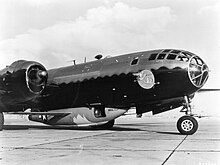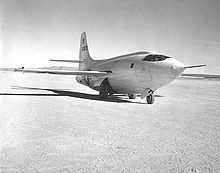Bell X-1
| Bell X-1 | |
|---|---|

|
|
| Type: | Experimental airplane |
| Design country: | |
| Manufacturer: | |
| First flight: |
January 25, 1946 |
| Commissioning: |
January 25, 1946 |
| Production time: |
1945 to 1955 |
| Number of pieces: |
6th |
The Bell X-1 was an American experimental and rocket aircraft that was built by the Bell Aircraft Co. for a joint research project between the US Air Force and the National Advisory Committee for Aeronautics (NACA). The single-seat middle - decker was specially developed to break the sound barrier in level flight.
history
The maiden flight of the Bell X-1 took place on January 25, 1946 without its own drive in pure gliding flight . Later, the first flights with an engine could be carried out.
First manned supersonic flight
On October 14, 1947, Captain Charles “Chuck” Yeager made the first manned horizontal supersonic flight with what he called “Glamorous Glennis” . The machine reached a speed of Mach 1.06 (1125 km / h) at about 13,100 m (43,000 ft) altitude.
Other flight services
On January 7, 1949, the Bell X-1 performed its first and only self-launch from the ground. With reduced fuel load, it took off from the USAF test site Muroc after a take-off distance of 700 meters and reached an altitude of 7015 meters within 100 seconds of flight time.
With the Bell X-1A version, the speed of Mach 2,435 was reached on December 12, 1953. The highest altitude achieved was 27,400 m.
construction
plane
The machine was dropped in the air from a mother aircraft (a Boeing B-29 or B-50 ) and then continued the flight in gliding flight or with its own engine. The machine has unarrowed wings and a cross tail . The landing gear was retractable. The fuselage was shaped according to the profile of a .50 BMG bullet , as this bullet was known to have a stable "attitude" at supersonic speed.
drive
The engine technology came from Reaction Motors Inc. and was a further development of the German rocket technology of the Second World War . The fuel, alcohol and oxygen, was transported into the combustion chambers by means of high pressure nitrogen.
First generation
Three machines were made from the original Bell X-1 . While the first machine was used by the American Air Force, the second machine went to the NACA, NASA's predecessor . The third machine was devastated after being able to perform only one glide flight.
Other versions
The Bell X-1A was similar to the X-1, but had a new cockpit canopy and a longer fuselage to accommodate a larger amount of fuel. The fuel system, which now worked with turbo pumps, was also new. This machine was also used by the American Air Force for research purposes. On December 12, 1953, the speed of Mach 2.435 was achieved. The highest altitude achieved was 27,400 m. The machine went to the NACA in September 1954 , which it wanted to use for further tests. Due to an explosion shortly before it was released for the second test flight at the NACA on August 8, 1955, the machine had to be abandoned. Test pilot Joe Walker climbed into the carrier aircraft, after which it was dropped unmanned and consequently destroyed on the ground when it hit.
The Bell X-1B was essentially the same as the Bell X-1A, but had a modified wing. This machine was also initially used by the American Air Force for high-speed test flights and then handed over to the NACA in January 1955. The machine used this for its research program until the beginning of 1958. It reached a speed of Mach 2.3 on December 2, 1954. After retirement, it was given as an exhibit in the Research & Development Gallery at Wright-Patterson Air Force Base ; it can be viewed there from the affiliated National Museum of the United States Air Force (as of June 2008).
There was a project for a Bell X-1C but it wasn't carried out. The Bell X-1D had to be dropped from its parent aircraft, a Boeing B-50, on August 22, 1951 and exploded in midair.
The final version, the Bell X-1E , was the second original Bell X-1 to be delivered to the NACA. New wings were mounted on this machine, the fuel system was updated with the turbo pumps and the windshield was changed. The first flight took place on December 12, 1955. The flight attempts continued until the end of 1958, then this X-1 was also retired.
The whereabouts of the six machines
- The Bell X-1 No. 1, Air Force serial number 46-062 ("Glamorous Glennis"), is open to the public in the Milestones of Flight gallery at the National Air and Space Museum in Washington, DC .
- The Bell X-1 No. 2, Air Force serial number 46-063, was later converted to the Bell X-1E and is located in front of the Neil A. Armstrong Flight Research Center at Edwards Air Force Base , California.
- Bell X-1 No. 3, Air Force serial number 46-064, exploded while defueling on November 9, 1951.
- The Bell X-1A, Air Force serial number 48-1384, had to be dropped unmanned from the carrier aircraft during the test flight on August 8, 1955 and was destroyed.
- The Bell X-1B, Air Force serial number 48-1385, is on display in the Research & Development Hangar of the National Museum of the United States Air Force at Wright-Patterson Air Force Base .
- The Bell X-1D, Air Force serial number 48-1386, exploded in midair on August 22, 1951 after an emergency release from the mother aircraft.
Technical specifications
- Length: 9.45 m
- Height: 3.30 m
- Span: 8.53 m
- Empty weight: 2.219 kg
- Takeoff weight: 6,078 kg
- Service ceiling: 19,000 m
- Top speed X-1: Mach 1.26 (1,540 km / h or 957 mph)
- Top speed X-1E: Mach 2.24 (2,333 km / h or 1,450 mph)
- Engine: a four-chamber rocket motor of the type XLR-11 from Reaction Motors Inc. with 26.69 kN thrust
Movie
The US film “ The Stuff the Heroes are Made of ” (1983), which received four Oscars , also tells the story of the American test flight program.
See also
Web links
Individual evidence
- ↑ Description on history.nasa.gov p. 5. (PDF; 1.2 MB) Retrieved on January 11, 2013 .
- ^ Military Factory - Aircraft, Vehicles, Artillery, Small Arms and Naval developments throughout recorded history . ( militaryfactory.com [accessed January 7, 2017]).
- ^ Lance Thompson: The X-Hunters . In: Air & Space / Smithsonian magazine . February / March 1995, ISSN 0886-2257 ( online ).
- ↑ Jay Miller; The X-Planes: X-1 to X-45; Midland Publishing; 3rd edition (July 2001), ISBN 1-85780-109-1 , pages 21ff




